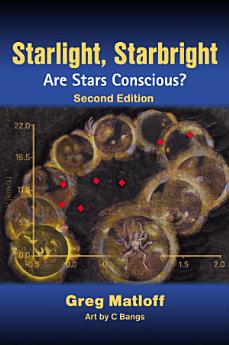Starlight Starbright: Are Stars Conscious? Second Edition
About this ebook
Or is the philosophical doctrine of panpsychism correct—are stars and the entire universe conscious in some sense?
Early chapters in this book examine the prehistory, mythology, and history of this topic. Arguments are presented from the viewpoints of shamans, philosophers, poets, quantum physicists, and novelists.
A simple “toy” model of panpsychism is then presented, in which a universal field of proto-
consciousness interacts with molecular bonds via the vacuum fluctuation pressure of the Casimir Effect. It is shown how this model is in congruence with an anomaly in stellar motions called “Parenago’s Discontinuity.” Cool, redder, less massive stars such as the Sun apparently circle the center of the galaxy faster than their hotter, bluer, more massive sisters. This discontinuity occurs at the point in the stellar distribution where molecules begin to appear in stellar spectra. As described in the first edition of this book, observations of main sequence stars out to ~260 light years and giant stars out to >1,000 light years—using the ESA Hipparcos space observatory—support the reality and non-locality of Parenago’s Discontinuity. Local, more conventional explanations for this phenomenon are not supported by observations of other galaxies and the spiral arms of the Milky Way.
Since 2014, the new ESA Gaia space observatory has been obtaining kinematics and position data for ~1 billion stars in our galaxy. The first Gaia data release in 2016 has been used in 2018 by a Russian team to demonstrate Parenago’s Discontinuity for a large stellar sample out to ~500 light years from the Sun. These observations support the hypothesis that anomalistic stellar motion is due to stellar volition, as described by philosopher/author Olaf Stapledon in his classic novel Star Maker, as previously discussed by the author in the peer-reviewed Journal of the British Interplanetary Society (JBIS).
In light of the new Gaia observations and work by other researchers, it is not impossible that panpsychism is emerging from the realm of philosophy as a new subdivision of observational astronomy. Simple models of universal proto-consciousness may be subject to inductive tests using current and future space observatories.
A special feature of this book is the chapter frontispiece art by C Bangs.
About the author
Gregory Matloff is a leading expert in possibilities for interstellar propulsion, especially near-Sun solar sail trajectories that might enable interstellar travel. He is also a professor with the Physics Department of New York City College of Technology, CUNY; a consultant with NASA Marshall Space Flight Center; a Hayden Associate of the American Museum of Natural History; and a Member of the International Academy of Astronautics.
C Bangs’ art investigates frontier science combined with symbolist figuration from an ecological feminist point of view. Her work is included in public and private collections as well as in books and journals. Public Collections include MoMA & Brooklyn Museum, artist book collections, Institute for Interstellar Studies, Custer Institute, Library of Congress, NASA’s Marshall Spaceflight Center, The British Interplanetary Society, New York City College of Technology, Pratt Institute, Cornell University, and Pace University.




